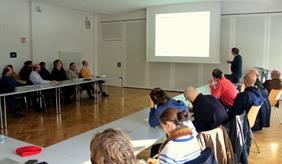
On January 11th, 2017 the ZALF-Institute for Landscape Hydrology welcomed colleagues and other interested listeners at their colloquium „Trend analysis: Sweet temptation, rude awakening". The head of the institute Prof. Dr. Gunnar Lischeid presented the work of a research team consisting of himself, Dr. Knut Kaiser (GFZ Potsdam), Peter Stüve (GFZ Potsdam), Prof. Dr. Gunnar Nützmann (IGB Berlin), Dr. Jörg Steidel (ZALF) and Dr. Ralf Dannowksi (ZALF). With an audience of 34 listeners the colloquium was very well attended, but considering the importance of the discussed topic this should not come as a surprise.
Prof. Lischeid talked about potential pitfalls when working with trend analysis, a tool easily utilized using standard software and whose results are apparently easily understood and communicated to a non-scientific public. Trend analysis is therefore often used to check for climate change or major anthropogenic effects on natural systems. However, often inconsistent patterns are found that are usually ascribed to local, mostly anthropogenic effects. On the other hand apparently inconsistent trends might be due to long-term persistence (Hurst-phenomenon). Therefore, apparent linear trends can result from low-frequency oscillations that are inherent to natural systems irrespective of human impacts.
To illustrate this problem, Prof. Lischeid presented a recent study of his team, that is aiming to subtract local effects from time series of lake water level and groundwater head that exhibited inconsistent trends during a 28 years period in North East Germany. The residuals were then tested for trends to be compared with those of precipitation and potential evapotranspiration. Inconsistent trends were primarily due to low-pass filtering of the infiltrating rain signal. Thus, minor long-term oscillations in the input signal would build up and become visible only after passage through the vadose zone, resulting in apparent linear trends.
Using this example, Prof. Lischeid was able to raise awareness for this fundamental problem inherent to trend analysis, but so far rarely considered in environmental sciences. Indeed significant long-term trends might indicate a major change in environmental systems. However, it is equally likely, that the trends might simply be due to natural long-term oscillations that are amplified via low-pass filtering in natural systems, resulting in apparent monotonic trends even for rather long periods. Thus outermost caution is advised when trend analysis is used in a naïve way.
